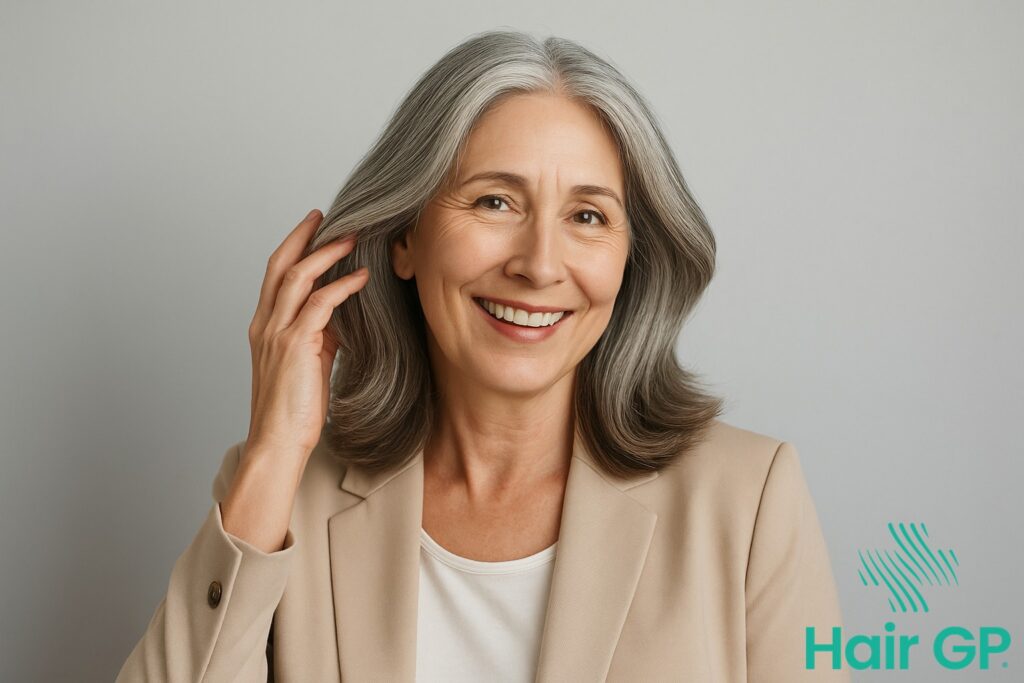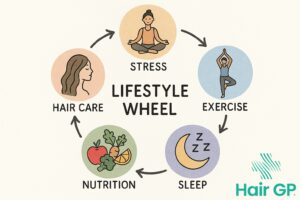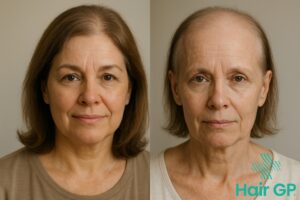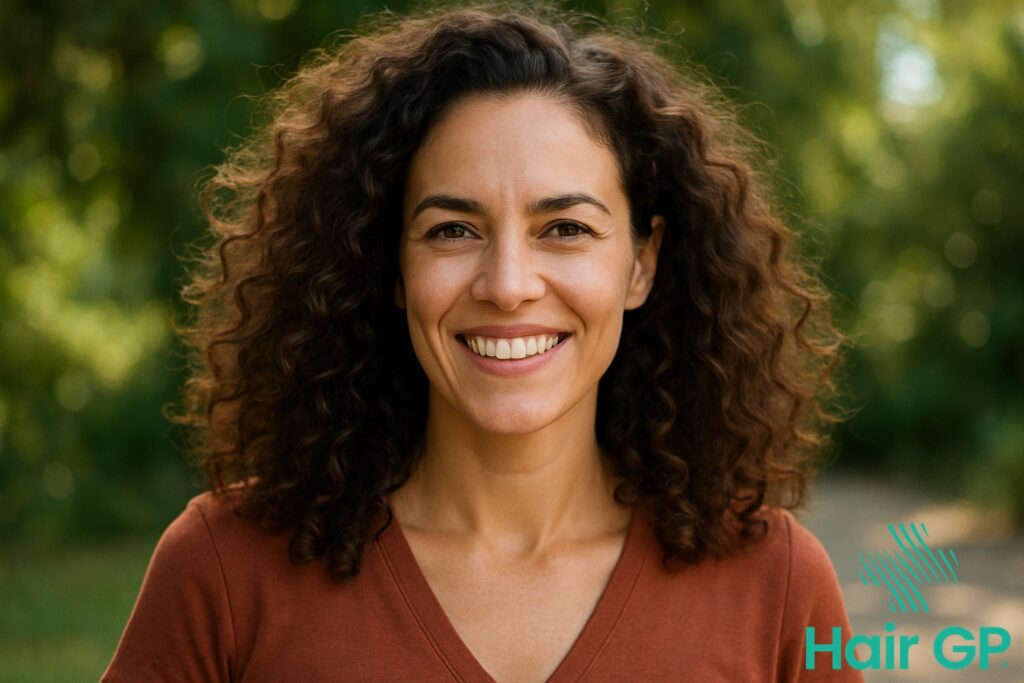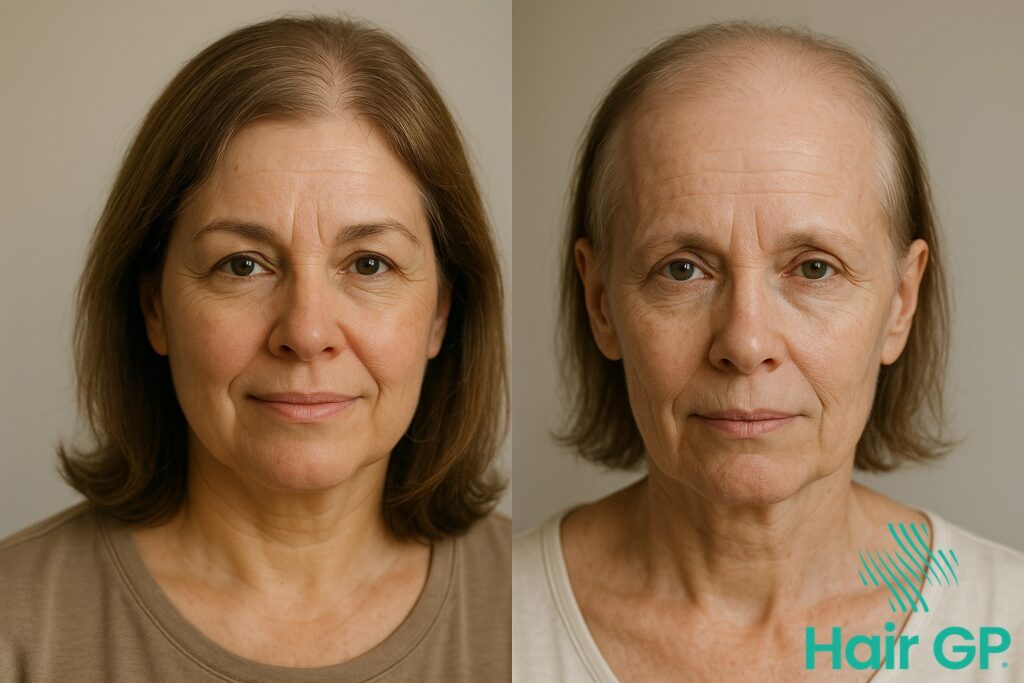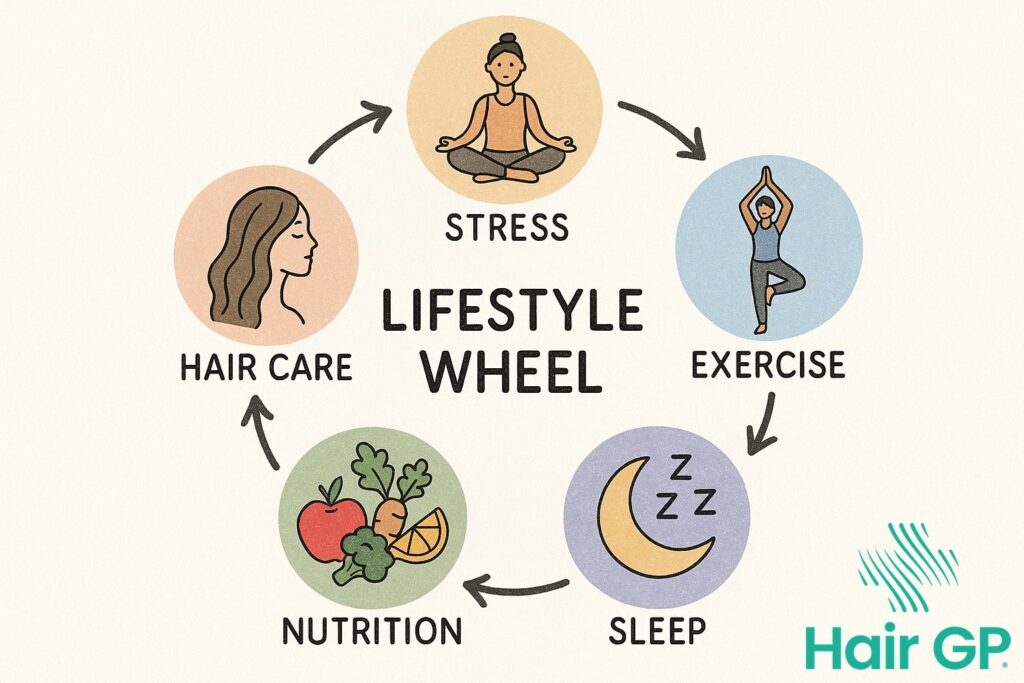Introduction
For many women, the menopause transition brings unexpected changes to their hair health that can be both surprising and distressing. Whilst hot flushes and mood changes are well-known menopause symptoms, the impact on hair is often overlooked, leaving women unprepared for the hair thinning and texture changes that frequently accompany this life stage.
During menopause, hormonal fluctuations can trigger significant hair changes, from gradual thinning across the scalp to more noticeable menopausal hair loss patterns. Many women notice their once-thick locks becoming finer, more brittle, or shedding more than usual. These changes aren’t just cosmetic concerns – they can profoundly affect self-esteem and quality of life during an already challenging transition.
This comprehensive guide explores the intricate relationship between hormonal shifts and hair follicle health, examining why these changes occur and what you can expect. We’ll delve into the science behind how declining oestrogen levels and other hormonal fluctuations disrupt normal hair growth cycles, leading to the various manifestations of hair loss and thinning that women experience.
Most importantly, you’ll discover evidence-based solutions ranging from medical treatments to natural approaches that can help manage and potentially reverse these changes. Whether you’re seeking pharmaceutical interventions or prefer lifestyle modifications and natural remedies, this guide provides practical strategies to support your hair health throughout the menopause transition. Understanding these changes is the first step towards finding effective solutions that work for your unique situation.
Key Takeaways – TL/DR
- Up to 40% of women experience significant hair thinning during menopause due to declining oestrogen levels
- Hair changes include thinning, texture alterations, increased shedding, and changes in hair growth patterns
- Treatment options range from hormone replacement therapy to topical minoxidil and lifestyle modifications
- Early intervention and proper hair care can minimise hair loss and maintain healthy hair growth
- Not all hair changes are permanent – many can be managed effectively with appropriate treatment
Understanding Menopause and Hair Changes
The connection between menopause and hair changes lies in the dramatic hormonal shifts that occur during this transition. As women navigate through perimenopause and menopause, fluctuating hormone levels directly impact hair follicles and growth cycles, leading to noticeable changes in hair density and texture.
The Role of Hormones in Hair Health
Oestrogen plays a protective role in maintaining healthy hair growth by prolonging the anagen (growth) phase of hair follicles. During menopause, as oestrogen levels drop significantly—decreasing by up to 60% within five years of the final menstrual period[1]—this protective effect diminishes. Simultaneously, androgen levels become relatively more dominant, though they too decline with age.
This shift in hormonal balance increases hair follicle sensitivity to dihydrotestosterone (DHT), an androgen that can miniaturise hair follicles. Research indicates that approximately 50% of women experience some degree of hair thinning by age 50[2], directly correlating with these hormone changes. The result is shorter growth cycles, finer hair strands, and reduced overall density.
Timeline of Hair Changes
Hair changes typically begin during perimenopause, which can start as early as the mid-forties. Initial changes are often subtle, with women noticing increased shedding or slightly thinner ponytails. The most pronounced changes usually occur within two to three years of the final menstrual period, when hormonal changes are most dramatic.
Postmenopausal patterns vary considerably among women. Some experience stabilisation of hair loss within a few years, whilst others may notice continued gradual thinning. The pattern often depends on genetic factors, overall health, and how dramatically hormone levels shift during the transition. Understanding this timeline helps women anticipate changes and seek appropriate support when needed.
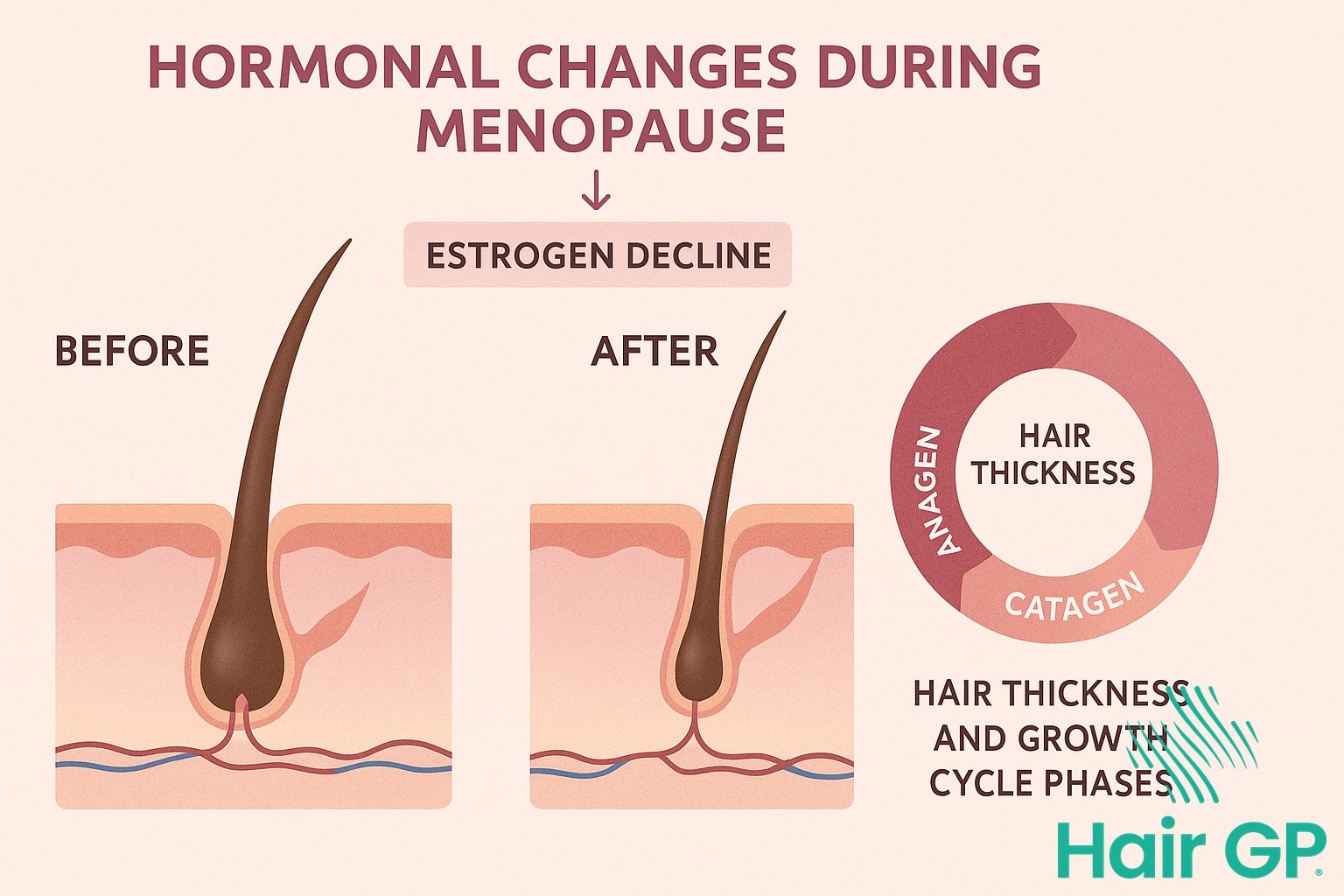
Common Hair Changes During Menopause
Many women notice significant changes to their hair during menopause, ranging from subtle shifts in texture to more visible hair thinning. Understanding these common manifestations helps women recognise normal menopausal changes and distinguish them from other conditions that might require different approaches.
Hair Thinning and Volume Loss
The most common concern during menopause is progressive hair thinning, which typically follows a distinct pattern. Female pattern hair loss often begins with a widening part line, particularly noticeable when styling hair or in photographs. Crown thinning becomes apparent as the scalp becomes more visible through the hair, especially under bright lighting. Unlike male pattern baldness, women rarely experience complete baldness but rather an overall density reduction that affects the entire scalp. This diffuse thinning can make ponytails feel thinner and reduce the hair’s ability to hold certain styles. Some women also experience telogen effluvium, a temporary condition where increased hair shedding occurs due to hormonal shifts, resulting in more hair in brushes and shower drains than usual.
Texture and Quality Changes
Beyond volume changes, many women notice their hair texture transforms during menopause. Previously smooth, manageable hair may become coarse, wiry, or brittle hair that’s prone to breakage. These hair shaft changes occur as oestrogen levels decline, affecting the hair’s protein structure and moisture retention. The emergence of grey hair often accelerates during this time, as melanin production decreases. New growth may feel different from existing hair, creating an uneven texture that’s challenging to style. Hair may also become drier and more prone to frizz, requiring different care products and techniques than before.
Other Related Symptoms
Hair changes rarely occur in isolation during menopause. Hot flushes can affect scalp health, causing excessive sweating that may irritate hair follicles and contribute to hair loss. Stress factors associated with menopause, including anxiety about bodily changes, can exacerbate hair shedding through the stress-hormone connection. Sleep disruption effects compound these issues, as poor sleep quality interferes with the body’s repair processes, including hair growth cycles. Understanding these interconnections helps women address hair concerns holistically rather than treating them as isolated symptoms.
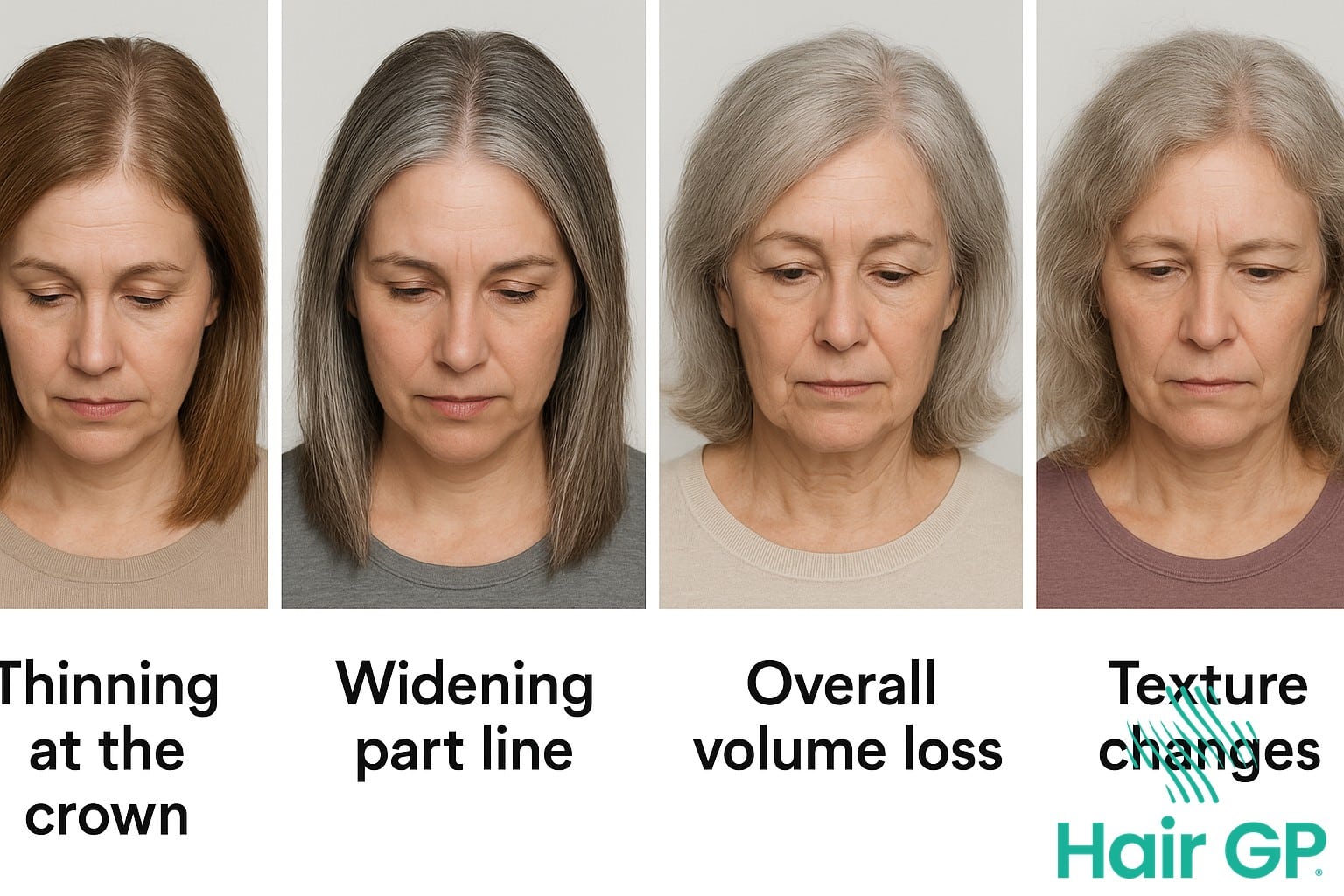
The Science Behind Hormonal Hair Changes
Understanding the scientific mechanisms behind menopausal hair changes reveals a complex interplay between hormones and the hair growth cycle. During menopause, declining oestrogen levels and relative androgen dominance fundamentally alter how hair follicles function, leading to thinning, shedding, and changes in hair texture.
Hair Growth Cycle Disruption
The normal hair growth cycle consists of three distinct phases: anagen (growth), catagen (transition), and telogen (resting). In healthy pre-menopausal women, approximately 85-90% of scalp hair remains in the anagen phase, which typically lasts 2-7 years [3]. However, hormonal fluctuations during menopause significantly disrupt this balance.
Declining oestrogen levels cause a shortened anagen phase, reducing the time hair follicles spend actively producing new hairs. Simultaneously, the telogen phase extends, meaning more follicles remain dormant for longer periods. This shift results in increased hair shedding and slower regrowth. Additionally, follicle miniaturisation occurs, where hair follicles progressively shrink, producing thinner, weaker strands that eventually cease functioning altogether [4].
Androgen Sensitivity and Hair Loss
The development of androgenetic alopecia during menopause stems from increased follicle sensitivity to androgens, particularly dihydrotestosterone (DHT). While androgen levels may remain stable or even decline, the protective effects of oestrogen diminish, allowing DHT to exert greater influence on susceptible hair follicles [5].
DHT binds to androgen receptors in follicles, triggering miniaturisation and shortened growth cycles. This process typically follows a distinct pattern, beginning with widening of the central part and progressing to diffuse thinning across the crown. Individual follicle sensitivity varies based on genetic factors, explaining why some women experience minimal hair loss whilst others develop significant thinning despite similar hormonal changes.
Treatment Options for Menopausal Hair Loss
Effective medical treatment options exist for managing menopausal hair loss, ranging from hormone replacement therapy to topical solutions containing the ingredient minoxidil. These evidence-based interventions can help restore healthy hair growth when properly prescribed and monitored by healthcare professionals.
Hormone Replacement Therapy
Hormone replacement therapy (HRT) addresses the underlying hormonal imbalances contributing to menopausal hair loss. Oestrogen supplementation can help maintain hair follicle health and promote hair growth by counteracting the relative increase in androgens that occurs during menopause [6]. Studies indicate that women receiving HRT often experience improved hair density and reduced thinning within 6-12 months of treatment initiation.
However, patient selection remains crucial, as HRT carries both benefits and risks that must be carefully evaluated. Healthcare providers consider factors including age, medical history, and individual risk profiles when determining HRT suitability for hair loss management.
Topical Treatments and Minoxidil
Minoxidil remains the most widely prescribed topical treatment for female pattern hair loss during menopause. Available in 2% and 5% formulations, this vasodilator stimulates hair follicles and prolongs the growth phase of the hair cycle. Clinical trials demonstrate that 5% minoxidil solution produces superior results, with approximately 60% of women experiencing visible hair regrowth after 16 weeks of consistent use [7].
Application methods involve applying the solution directly to affected scalp areas once daily. Patients should maintain realistic expectations, as visible improvements typically emerge after 3-4 months of continuous use, with maximum benefits observed at 12-16 months.
Alternative Medical Options
Beyond HRT and minoxidil, several prescription options support healthy hair growth in menopausal women. Anti-androgens like spironolactone can reduce androgen-related hair loss by blocking hormone receptors at the follicle level. Supplements containing zinc, iron, and vitamin D may address nutritional deficiencies contributing to hair thinning.
Other prescription options include finasteride for severe cases and platelet-rich plasma therapy for stimulating follicle regeneration. These treatment options require careful medical supervision and regular monitoring to ensure optimal outcomes whilst minimising potential side effects.
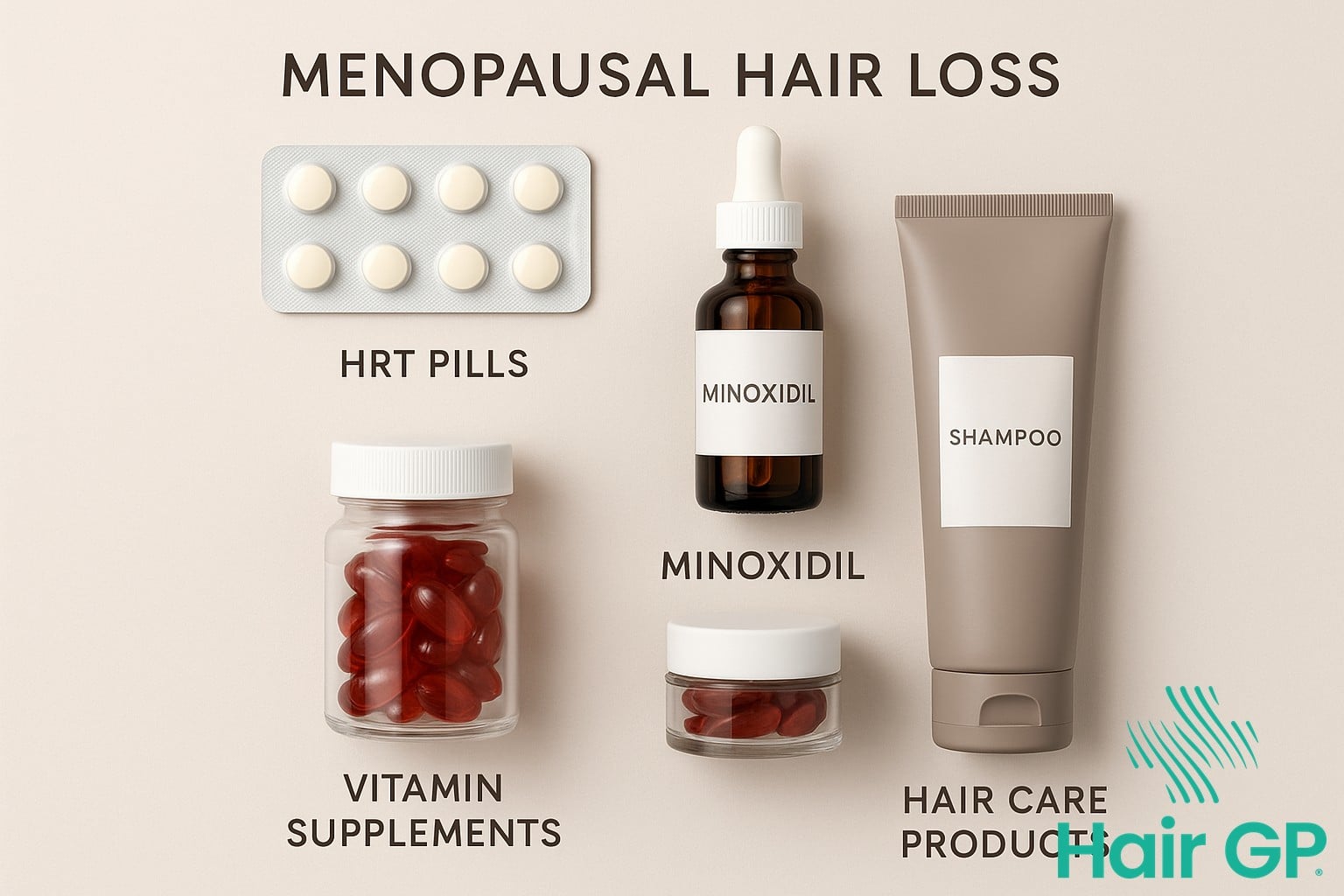
Natural Remedies and Lifestyle Changes
Supporting hair health during menopause doesn’t always require medical intervention – many natural approaches can significantly improve hair condition and growth. By implementing targeted dietary changes, adopting gentle hair care routines, and managing stress levels, women can maintain healthier, stronger hair throughout their menopausal journey.
Nutrition for Hair Health
A healthy diet forms the foundation for maintaining strong, healthy hair during menopause. Adequate protein intake is crucial, as hair is primarily composed of keratin protein – aim for lean meats, fish, eggs, and legumes daily. Iron deficiency commonly contributes to hair loss, so include iron-rich foods like spinach, red meat, and fortified cereals alongside vitamin C sources to enhance absorption. Omega-3 fatty acids found in salmon, walnuts, and flaxseeds support scalp health and may promote thicker hair growth whilst reducing inflammation that can impact hair density.
Hair Care Best Practices
Gentle hair care routines can minimise hair breakage and preserve existing strands. Switch to lukewarm water when washing, as hot water strips natural oils and weakens hair structure. Reducing heat styling frequency and using heat protectant products when necessary prevents further damage to already fragile hair. Protective hairstyles like loose braids or silk scrunchies reduce mechanical stress, whilst avoiding tight ponytails and harsh brushing helps maintain hair density by preventing unnecessary pulling and breakage.
Stress Management and Sleep
Chronic stress elevates cortisol levels, which can accelerate hair loss and disrupt the growth cycle. Incorporating relaxation techniques such as yoga, meditation, or deep breathing exercises helps regulate cortisol production. Quality sleep is equally important – aim for 7-9 hours nightly to support hair regeneration processes. Establishing a calming bedtime routine, limiting screen time, and maintaining consistent sleep schedules optimises both sleep quality and hair health, creating favourable conditions for healthy hair growth during menopause.
Conclusion
Understanding menopausal hair changes is crucial for women navigating this life transition. As we’ve explored, hormonal fluctuations during menopause can significantly impact hair health, leading to thinning, texture changes, and increased shedding. These hair changes, whilst distressing, are amongst the most common menopause symptoms experienced by women worldwide.
The good news is that numerous treatment options are available to help manage and improve menopausal hair concerns. From hormone replacement therapy and targeted supplements to specialised hair care routines and lifestyle modifications, women have various strategies to maintain healthy hair during this phase. What works best often depends on individual circumstances, overall health, and the severity of symptoms.
Remember that you’re not alone in experiencing these changes, and seeking support is a sign of strength, not weakness. Professional guidance from healthcare providers, trichologists, or menopause specialists can provide personalised solutions tailored to your specific needs. Taking proactive steps early, whether through dietary adjustments, stress management, or appropriate treatments, can make a significant difference in maintaining hair health throughout menopause and beyond. With the right approach and support, you can successfully navigate these changes whilst maintaining confidence in your appearance.
Frequently Asked Questions
Hair loss during menopause is not always permanent. While some changes like female pattern hair loss may be ongoing, many women experience temporary shedding that improves with treatment. Early intervention with appropriate therapies can help maintain hair density and promote regrowth.
Consult a healthcare provider if you notice sudden or patchy hair loss, experience hair loss along with other concerning symptoms, or if thinning significantly impacts your quality of life. A doctor can rule out other causes like thyroid issues or alopecia areata and recommend appropriate treatments.
Yes, a healthy diet rich in proteins, iron, vitamins D and B12, and omega-3 fatty acids can support hair health during menopause. While diet alone may not prevent all hair changes, proper nutrition provides essential building blocks for healthy hair growth and can minimize excessive shedding.
Most hair loss treatments require patience. Minoxidil typically shows results after 3-4 months of consistent use. Hormone replacement therapy may improve hair health within 6 months. Natural approaches like dietary changes and supplements may take 3-6 months to show noticeable improvements.
References
- Santoro N, Epperson CN, Mathews SB. Menopausal Symptoms and Their Management. Endocrinol Metab Clin North Am. 2015;44(3):497-515.
- Goluch-Koniuszy ZS. Nutrition of women with hair loss problem during the period of menopause. Prz Menopauzalny. 2016;15(1):56-61.
- Grymowicz M, Rudnicka E, Podfigurna A, et al. Hormonal Effects on Hair Follicles. Int J Mol Sci. 2020;21(15):5342.
- Mirmirani P. Hormonal changes in menopause: do they contribute to a ‘midlife hair crisis’ in women? Br J Dermatol. 2011;165 Suppl 3:7-11.
- Herskovitz I, Tosti A. Female pattern hair loss. Int J Endocrinol Metab. 2013;11(4):e9860.
- Blume-Peytavi U, Atkin S, Gieler U, Grimalt R. Skin Academy: hair, skin, hormones and menopause – current status/knowledge on the management of hair disorders in menopausal women. Eur J Dermatol. 2012;22(3):310-318.
- van Zuuren EJ, Fedorowicz Z, Schoones J. Interventions for female pattern hair loss. Cochrane Database Syst Rev. 2016;(5):CD007628.

